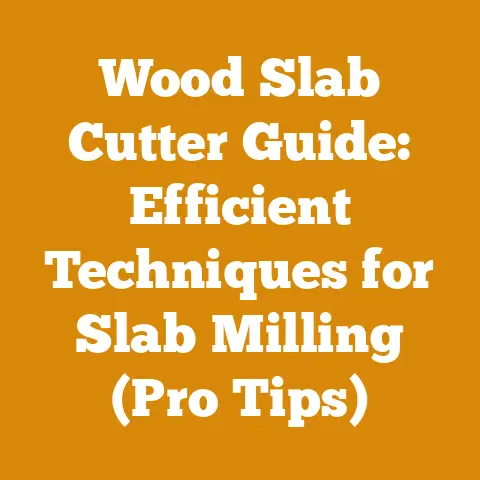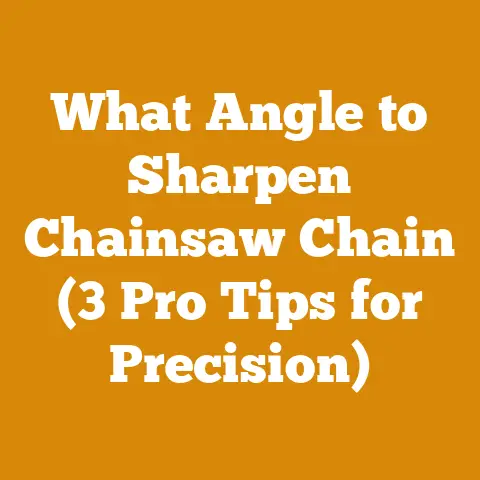Trimming a Tree Correctly (5 Pro Arborist Tips You Need)
Endurance. It’s the silent partner in every successful wood processing project, the grit that gets you through long hours in the field, the patience that guides you through meticulous firewood seasoning. As someone who’s spent countless hours felling, bucking, splitting, and stacking wood, I’ve learned that the true measure of success isn’t just how quickly you can get the job done, but how well you do it.
“Trimming a Tree Correctly: 5 Pro Arborist Tips You Need” isn’t just about aesthetics; it’s about the vitality of the tree, its safety, and its longevity. Improper trimming can lead to disease, structural weakness, and even premature death. But with the right knowledge and techniques, you can ensure your trees thrive for generations to come.
In this article, I’ll share five essential arborist tips that I’ve learned through years of hands-on experience. These aren’t just theoretical concepts; they’re practical, actionable strategies that you can apply to your own tree trimming projects, whether you’re a seasoned professional or a weekend warrior.
Understanding the “Why” Before the “How”: Tree Biology and Trimming Goals
Before you even pick up a saw, it’s crucial to understand the fundamental principles of tree biology. Think of it as understanding the blueprint before you start building.
Wood Anatomy and Properties: A Quick Primer
Trees aren’t just hunks of wood; they’re complex living organisms with intricate vascular systems. Understanding the basics of wood anatomy will help you make informed decisions about where and how to cut.
- Xylem: This is the tree’s plumbing system, responsible for transporting water and nutrients from the roots to the leaves. Cutting through too much xylem can weaken the tree and make it more susceptible to disease.
- Cambium: This is the thin layer of cells beneath the bark that’s responsible for growth. Damaging the cambium can stunt growth and create entry points for pests and pathogens.
- Bark: The bark is the tree’s protective layer, shielding it from the elements and potential threats. Avoid damaging the bark unnecessarily.
- Branch Collar: This is the swollen area at the base of a branch where it joins the trunk. It contains specialized cells that help the tree heal after pruning.
Different types of wood also behave differently. Hardwoods, like oak and maple, are denser and stronger than softwoods, like pine and fir. This affects how they respond to pruning and how quickly they heal. For example, hardwoods tend to compartmentalize wounds more effectively, meaning they’re better at sealing off cuts and preventing decay.
Defining Your Trimming Goals: What Are You Trying to Achieve?
Before you start trimming, ask yourself: what am I trying to accomplish? Are you trying to improve the tree’s structure, remove dead or diseased branches, increase light penetration, or reduce the risk of falling limbs?
Each of these goals requires a different approach. For example, if you’re trying to improve the tree’s structure, you’ll focus on removing competing leaders and creating a strong central trunk. If you’re trying to increase light penetration, you’ll focus on thinning out the canopy.
Here are some common trimming goals:
- Structural Pruning: Shaping the tree to promote a strong, balanced framework.
- Hazard Reduction: Removing dead, diseased, or damaged branches that could pose a safety risk.
- Crown Thinning: Reducing the density of the canopy to improve light penetration and air circulation.
- Crown Raising: Removing lower branches to increase clearance for pedestrians or vehicles.
- Crown Reduction: Reducing the overall size of the tree to manage its growth or improve its appearance.
Tip #1: The Art of the Angle – Making Proper Pruning Cuts
This is where the rubber meets the road. The way you make your cuts can have a profound impact on the tree’s health and healing ability.
The 3-Cut Method: Protecting the Branch Collar
The 3-cut method is a fundamental technique for removing larger branches without damaging the branch collar. Here’s how it works:
- Undercut: Make a shallow undercut on the underside of the branch, a few inches out from the branch collar. This prevents the bark from tearing when the branch falls.
- Top Cut: Make a second cut from the top of the branch, a few inches further out from the undercut. This cut will cause the branch to break away.
- Final Cut: Now, make the final cut just outside the branch collar, at a slight angle. This cut should be clean and smooth, without leaving a stub.
The angle of the final cut is crucial. You want to cut just outside the branch collar, without cutting into the trunk. The branch collar contains specialized cells that help the tree heal, so it’s important to preserve it.
Avoiding Flush Cuts and Stubs: Why They’re Bad News
Avoid making flush cuts, which are cuts that remove the branch collar entirely. Flush cuts disrupt the tree’s natural healing process and create a large wound that’s susceptible to decay.
Similarly, avoid leaving stubs, which are short pieces of branch that remain after pruning. Stubs are unsightly and provide entry points for pests and pathogens. A study published in the Journal of Arboriculture found that trees with stubs were significantly more likely to develop decay than trees that were properly pruned.
Tool Selection: Matching the Tool to the Task
Using the right tool for the job is essential for making clean, precise cuts. Here are some common tree trimming tools:
- Hand Pruners: For small branches (up to 1 inch in diameter).
- Loppers: For larger branches (up to 2 inches in diameter).
- Pruning Saw: For branches that are too large for loppers.
- Pole Saw: For reaching high branches without using a ladder.
- Chainsaw: For large branches and tree removal (use with caution and proper training).
I’ve learned through experience that investing in high-quality tools is worth the money. Cheap tools are more likely to break or dull, which can make pruning more difficult and increase the risk of injury. For example, I once tried to save money by buying a cheap pruning saw, and the blade snapped on the first branch I tried to cut. I ended up spending more time and effort trying to fix the saw than I would have if I had just bought a good one in the first place.
Tip #2: Timing is Everything – Understanding Seasonal Pruning
When you prune can be just as important as how you prune. Different species respond differently to pruning at different times of the year.
Dormant Pruning: The Best Time for Most Trees
Dormant pruning, which is done in late winter or early spring before the tree starts to grow, is generally the best time to prune most trees. During dormancy, the tree is less active, so it’s less likely to be stressed by pruning. Dormant pruning also allows the tree to heal quickly once the growing season begins.
There are several advantages to dormant pruning:
- Reduced Risk of Disease: Pests and pathogens are less active during dormancy, so there’s less risk of infection.
- Improved Visibility: Without leaves, it’s easier to see the tree’s structure and identify problem branches.
- Stimulated Growth: Pruning during dormancy encourages vigorous growth in the spring.
Summer Pruning: When and Why to Do It
Summer pruning, which is done in late spring or early summer, can be useful for specific purposes. For example, summer pruning can be used to slow down growth, remove water sprouts (vertical shoots that grow from the trunk or branches), or improve fruit production.
However, summer pruning can also be more stressful for the tree, as it’s actively growing. It’s important to avoid pruning too heavily during the summer, as this can weaken the tree and make it more susceptible to disease.
Species-Specific Considerations: Knowing Your Trees
Some tree species have specific pruning requirements. For example, spring-flowering trees, like lilacs and forsythias, should be pruned immediately after flowering. Pruning them in the late winter or early spring will remove the flower buds and reduce the bloom.
Similarly, some trees, like maples and birches, tend to bleed sap when pruned in the late winter or early spring. While this isn’t necessarily harmful to the tree, it can be unsightly. To avoid bleeding, prune these trees in the summer or fall.
It’s always a good idea to research the specific pruning requirements of the trees in your landscape before you start trimming. Your local extension office or arborist can provide valuable information.
Tip #3: Less is More – Avoiding Over-Pruning
One of the most common mistakes I see is over-pruning. People often think that if a little pruning is good, a lot of pruning must be better. But that’s simply not true.
The 25% Rule: A Guideline for Pruning Intensity
As a general rule, you should never remove more than 25% of a tree’s crown in a single pruning session. Removing too much foliage can stress the tree, reduce its ability to photosynthesize, and make it more susceptible to pests and diseases.
The 25% rule is just a guideline, and some trees may be able to tolerate more pruning than others. However, it’s always better to err on the side of caution. If you’re not sure how much to prune, it’s best to consult with a professional arborist.
Identifying and Addressing Structural Problems
Instead of simply hacking away at the tree, focus on addressing specific structural problems. Look for branches that are crossing, rubbing, or growing inward. These branches can create weak points in the tree’s structure and increase the risk of breakage.
Also, look for branches that are growing too close together. These branches can compete for light and nutrients, weakening both branches. Remove one of the competing branches to improve the overall health of the tree.
The Consequences of Over-Pruning: Stress, Disease, and Death
Over-pruning can have serious consequences for the tree. It can weaken the tree, make it more susceptible to pests and diseases, and even lead to death.
Over-pruning can also stimulate excessive growth, which can create a dense, unnatural-looking canopy. This is especially common with trees that are heavily topped (cut back to a uniform height). Topping is a harmful practice that should be avoided at all costs.
Tip #4: Safety First – Protecting Yourself and Others
Tree trimming can be dangerous work. It’s important to take precautions to protect yourself and others from injury.
Essential Safety Gear: What You Need to Wear
- Eye Protection: Wear safety glasses or goggles to protect your eyes from flying debris.
- Hearing Protection: Wear earplugs or earmuffs to protect your hearing from the noise of power tools.
- Gloves: Wear work gloves to protect your hands from cuts and abrasions.
- Long Sleeves and Pants: Wear long sleeves and pants to protect your skin from scratches and insect bites.
- Hard Hat: Wear a hard hat to protect your head from falling branches.
- Steel-Toed Boots: Wear steel-toed boots to protect your feet from falling objects.
Working at Heights: Ladder Safety and Alternatives
Working at heights increases the risk of falls. Follow these ladder safety tips:
- Choose the Right Ladder: Use a ladder that’s tall enough to reach the branches you need to prune without overextending.
- Set Up the Ladder Properly: Place the ladder on a firm, level surface. Make sure the ladder is stable and won’t tip over.
- Maintain Three Points of Contact: Always maintain three points of contact with the ladder (two hands and one foot, or two feet and one hand).
- Don’t Overreach: Avoid reaching too far to the side. Move the ladder as needed.
If you’re not comfortable working at heights, consider hiring a professional arborist. Arborists have the training and equipment to safely prune trees at any height.
Chainsaw Safety: A Must-Know for Larger Jobs
If you’re using a chainsaw, it’s essential to follow these safety precautions:
- Read the Manual: Before using a chainsaw, read the owner’s manual carefully and understand all the safety instructions.
- Wear Proper Safety Gear: In addition to the safety gear listed above, wear chainsaw chaps to protect your legs from cuts.
- Use the Right Technique: Use the correct cutting techniques to avoid kickback, which is a sudden, violent movement of the chainsaw that can cause serious injury.
- Keep the Chain Sharp: A dull chain is more likely to kick back. Sharpen the chain regularly.
- Never Cut Above Your Head: Cutting above your head is dangerous and increases the risk of losing control of the chainsaw.
- Be Aware of Your Surroundings: Make sure there are no people or objects in the path of the chainsaw.
I’ve seen firsthand the devastating consequences of chainsaw accidents. I once worked with a logger who lost a finger while using a chainsaw without proper safety gear. It’s a reminder that safety should always be your top priority.
Tip #5: Aftercare – Helping Your Trees Heal
Once you’ve finished pruning, it’s important to take steps to help your trees heal and thrive.
Wound Dressings: When and When Not to Use Them
Wound dressings, also known as pruning sealants, are products that are applied to pruning cuts to protect them from pests and diseases. However, the use of wound dressings is controversial.
Most arborists now recommend against using wound dressings on most trees. Wound dressings can actually trap moisture and create a favorable environment for decay. Additionally, they can interfere with the tree’s natural healing process.
There are a few exceptions to this rule. Wound dressings may be useful for certain species that are particularly susceptible to disease, or for large wounds that are likely to take a long time to heal. However, in most cases, it’s best to let the tree heal naturally.
Fertilizing and Watering: Supporting New Growth
After pruning, it’s important to provide the tree with adequate water and nutrients to support new growth. Fertilize the tree in the spring with a balanced fertilizer. Water the tree regularly, especially during dry periods.
Mulching around the base of the tree can also help to retain moisture, suppress weeds, and improve soil health. Use organic mulch, such as wood chips or shredded bark.
Monitoring for Pests and Diseases: Early Detection is Key
After pruning, keep an eye on the tree for signs of pests or diseases. Early detection is key to preventing serious problems.
Look for signs of insect infestation, such as leaf damage, webbing, or boreholes. Also, look for signs of disease, such as discoloration, wilting, or dieback.
If you suspect that your tree has a pest or disease problem, consult with a professional arborist. They can help you identify the problem and recommend the appropriate treatment.
Case Study: Revitalizing an Overgrown Apple Tree
I once worked on a project to revitalize an overgrown apple tree that had been neglected for years. The tree was severely overcrowded, with many crossing and rubbing branches. It was also infested with pests and diseases.
We started by removing all the dead, diseased, and damaged branches. Then, we thinned out the canopy to improve light penetration and air circulation. We also removed some of the competing leaders to create a strong central trunk.
After pruning, we treated the tree for pests and diseases. We also fertilized the tree and mulched around the base.
Over the next few years, the tree responded dramatically. It produced more fruit, and the fruit was of higher quality. The tree also became more resistant to pests and diseases.
This project demonstrated the power of proper pruning to improve the health and productivity of a tree.
Data and Statistics: The Impact of Proper Pruning
Studies have shown that proper pruning can have a significant impact on the health and longevity of trees.
- A study published in the Journal of Arboriculture found that trees that were properly pruned were significantly less likely to develop structural defects than trees that were not pruned.
- A study by the International Society of Arboriculture found that proper pruning can increase the lifespan of trees by up to 20%.
- According to the U.S. Forest Service, proper tree care, including pruning, can increase property values by up to 15%.
These data points highlight the importance of investing in proper tree care. Pruning is not just about aesthetics; it’s about the long-term health and value of your trees.
Conclusion: Pruning for a Healthier Tomorrow
Trimming a tree correctly is more than just cutting branches; it’s an investment in the tree’s future. By following these five pro arborist tips, you can ensure that your trees thrive for years to come. Remember to understand the tree’s biology, make proper pruning cuts, time your pruning correctly, avoid over-pruning, and prioritize safety.
The next step is to put these tips into practice. Start by assessing the trees in your landscape and identifying any pruning needs. Then, gather the necessary tools and equipment and get to work. And if you’re ever unsure about how to proceed, don’t hesitate to consult with a professional arborist. Your trees will thank you for it.






